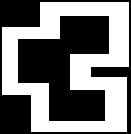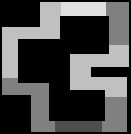Modeling with 3D Editor
This is part of the Custom Track tutorial. Back to the main tutorial page
Modeling can be done either in MS Paint (only MS Paint, not any other image editor) or in a 3D model editor.
Using Miscrosoft Paint
1.
Open Paint and create a new 150x150 image. You have to make the image as small as possible, as long as it contains all of your map. You can make it bigger if you need to.
Before starting to paint make the whole picture black (color #000000). This doesn't get recognized in the model importer.
First, set up some basic greyscales. Greyscales are colours with the same RGB values (e.g. #3F3F3F). If you use any 'colored' color, SZS Modifier won't be able to import it.
2.
After the setup you can start painting now. Paint the map of your track, the same one that would get displayed in the bottom right of the screen ingame.
Remember that simpler drawings have higher chances of getting imported:
The grayscale must be set up like this: The higher you want the track to be, the closer to white. So...
If you want the track to be highter, you make it lighter. If you want it to be lower, make it darker.
To make ramps, use a gradient.
To make straight walls, you have to import really steep slopes, and use the Pinch tool to transform then into walls.
3.
Save your image as a PNG file. Make multiple image files, each with a different part of the road: One with the normal road, one with the offroad, one with the walls, etc. You have to do this so each can have it's own texture and each gets it's own behaviour ingame. To put the track you just made inside the file, you must use the Model Creator tool.
Using a 3D modeling program
The most used programs for making CT's are 3ds max and Google Sketch-up (GSU).
To make a track with 3D modeling software, you need to export your model as obj file.
Exporting obj files with:
3ds max
to be made by someone who uses 3ds max
Google SketchUp
Even when pro GSU has an obj exporter, you can't use it. It exports in a format the szs modifier can't read. Instead you have to use a plugin: obj exporter by Marten van der Honing
Put the .rb file in the plugins folder of GSU.
Settings to tick:
Export back faces, UV helper, selected only.
Export back faces to create clockwise culling (white faces are the visible and solid (after kcl creation) sides), UV helper to export texture mapping and selected only to separate polygons.
To enable texture mapping support, you need to texture BOTH sides of the face.
How to model the track:
Start with drawing a simple square, than draw your track on it in 2D (so the road). After that, make the road in 3D (raising some parts). When you're done with the road, you start making walls etc. Make smart use of GSU's tools to realise it. When you're done with your model, start de-complexing it, aka delete everything you don't need. Finally texture the model, and you're ready to export.
TIP: make use of the component tool to separate different parts of the track (at the same way your polygons will appear).
Export everything OUTSIDE components, the obj exporter can't export components, and no texturing if you export inside a component.
What to do with the exported obj files:
Before you can import the files into the szs modifier, you need to do some things, else you'll get an "invalid" error.
Open all your exported files with notepad. Remove the 1st 2 lines of each file, and replace all dots into comma's (use replace tool). Than save.
Now you are ready to import into the szs modifier, and that's the end of the GSU section.
Tools
After Importing
Now, you follow the Texturing tutorial to see how to fix the colors of the track so that they're the way you want to.


